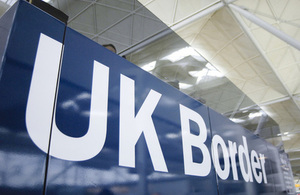Inspection report finds number of potential victims of modern slavery identified is low
New from the Independent Chief Inspector of Borders and Immigration last week was an inspection report on the Border Force's identification and treatment of potential victims of modern slavery.
 Image credit: UK GovernmentThe 48-page report, produced in collaboration with the Independent Anti-Slavery Commissioner, can be read here.
Image credit: UK GovernmentThe 48-page report, produced in collaboration with the Independent Anti-Slavery Commissioner, can be read here.
The report finds that that the number of potential victims of modern slavery and traffickers identified by the Border Force is low.
According to the report, there are an estimated 10,000 to 13,000 victims of modern slavery present in the UK, though there is no verifiable figure. In 2015, 3,266 potential victims of modern slavery were referred to the National Referral Mechanism (NRM).
The report notes: "Data from the Home Office Performance Risk and Analysis Unit (PRAU) indicated that between 1 April 2014 and 31 March 2015, Border Force identified 313 potential victims of modern slavery, and between 1 April 2015 and 31 March 2016 it identified a further 312."
The Independent Chief Inspector says the Border Force's targets for identifying victims appear modest, and he is also concerned that the "poor standard of record keeping and different datasets in use mean that Border Force cannot be certain whether any targets are being met."
In addition, the report found that between April 2014 and 2016, only two cases of traffickers identified by the Border Force resulted in prosecution and conviction.
The report concludes: "Overall, the inspection struggled to obtain a clear and reliable picture of Border Force performance in identifying potential victims of modern slavery, in referring cases into the NRM, in the appropriateness of other outcomes including removals, and in identifying traffickers and referring them for investigation (primarily by Immigration Enforcement). This was because of the lack of detail recorded in paper and electronic case files, and the different datasets in use. For the same reasons, management assurance of these processes cannot hope to be effective, and Border Force is not creating the evidence base from which to learn and improve. More seriously, it may also be failing potential victims. The priority must be to improve the collection, recording and analysis of data, in order to inform operational activity and the training and development needs of staff, and to ensure that Border Force is delivering what the Modern Slavery Act and Modern Slavery Strategy require of it."
Kevin Hyland, the Independent Anti-Slavery Commissioner, said: "There is a strong chance we are missing thousands of victims of modern slavery at our borders. I am pleased that nearly all recommendations in this report have been accepted, but I am concerned that we are missing the mark in safeguarding victims."
"We must urgently improve our response, regardless of how challenging it is. If Border Force identified 265 potential victims at the border between April and November last year, as outlined in the report, and yet only 57 entered government funded support, what happened to the remaining 208?"
In the foreword to the report, Hyland says: "This is not simply a matter of numbers, targets and processes for Border Force to manage; human lives are at stake and people's freedom is in question. Modern slavery is an evil that debilitates and destroys lives and demands an appropriate response."
Nick Nason, legal consultant at Farha & Associates, wrote on Free Movement: "The overall sense given by this inspection report is that identifying traffickers and the potential victims of slavery is nowhere near the top of the Border Force priority list, and that the department is simply going through the motions. … The main bugbear outlined in the report … is with the quality of the record keeping. Without it, the Border Force is 'not creating the evidence base from which to learn and improve' and cannot be held meaningfully accountable by independent reports such as this one."
The Home Office's 10-page response to the Independent Chief Inspector's report can be read here.